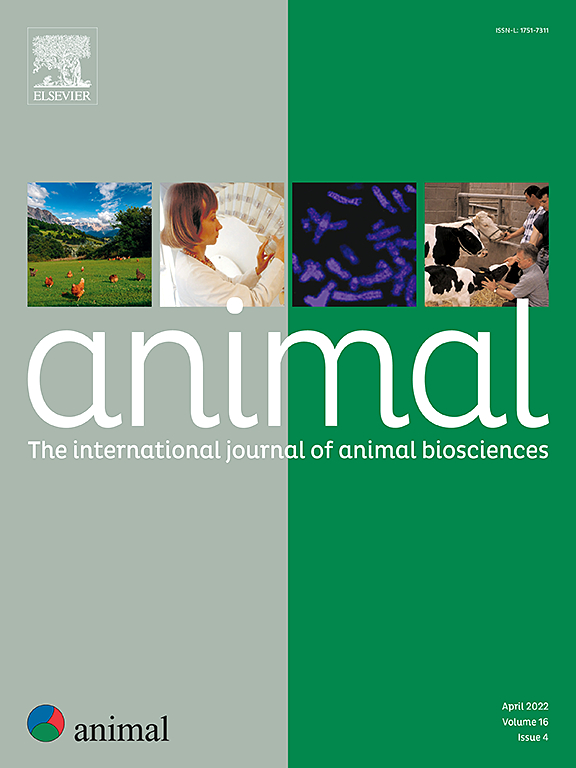Effect of antioxidant and osmolyte enriched or energy-dense diet on heat−stressed fattening pigs
IF 4.2
2区 农林科学
Q1 AGRICULTURE, DAIRY & ANIMAL SCIENCE
引用次数: 0
Abstract
Heat stress negatively affects pig welfare, health and production. Osmolytes and antioxidants are considered potential mitigators of heat stress-induced damage. Modification of feed composition, specifically lower CP, also aims to reduce internal metabolic heat production. This study investigated the effect of an enriched or energy-dense (E-dense) diet on heat-stressed fattening pigs (n = 192 in total). Dietary treatments were administered (ad libitum) when pigs reached ± 80 kg. The control diet comprised 15% CP, 3.6% crude fat, 9.1 MJ/kg net energy, 0.4 mg/kg inorganic selenium (Se), and 100 ppm vitamin E; the enriched diet contained the same chemical composition but was supplemented with 0.2 mg/kg inorganic Se, 0.2 mg/kg selenomethionine, 200 ppm vitamin E, 200 ppm vitamin C and 0.1% betaine; the E-dense diet featured 13.6% CP, 6.6% crude fat, and increased energy (9.7 MJ/kg) and lysine content. The lysine:energy ratio of all three diets was the same. A 1-week heat wave (± 30 °C and Temperature-Humidity Index of ± 78.4) was induced 2 times when pigs were 20 and 22 weeks old. Physiological parameters and performance parameters were assessed weekly. At the end of the trial, carcass and meat quality were evaluated. Additive enrichment of the diet resulted in a numerically increased daily gain over the 6-week trial compared to the control group (925 vs 891 g/day), P = 0.090). The E-dense group had a higher increase in rectal temperature during heat load compared to the control group (0.38 vs 0.28 °C, P = 0.018). Over the entire trial, the E-dense group had a higher feed conversion ratio than the control group (2.95 vs 2.67, P = 0.006). Carcass traits revealed increased fat thickness of 0.9 mm in the E-dense group (P = 0.035), along with lower lean meat content (−1.1%, P = 0.002). The meat of the enriched group displayed elevated vitamin E and Se levels (P < 0.001), which may be beneficial for the consumer. Overall, the nutritional strategies did not significantly prevent physiological heat stress or enhance performance, but the supplementation of antioxidants and osmolytes tended to ameliorate daily gain over the entire trial.
抗氧化和富含渗透液或高能量日粮对热应激育肥猪的影响
热应激对猪的福利、健康和生产产生负面影响。渗透剂和抗氧化剂被认为是热应激诱导损伤的潜在缓解剂。修改饲料成分,特别是降低粗蛋白质,也是为了减少体内代谢热的产生。本研究研究了富集或能量密集饲粮(E-dense)对热应激育肥猪(n = 192)的影响。当猪长到±80 kg时,进行饲粮处理(随意)。对照组饲粮为15%粗蛋白质、3.6%粗脂肪、9.1 MJ/kg净能、0.4 mg/kg无机硒和100 ppm维生素E;在化学成分相同的强化饲粮中添加0.2 mg/kg无机硒、0.2 mg/kg硒代蛋氨酸、200 ppm维生素E、200 ppm维生素C和0.1%甜菜碱;e密度饲粮粗蛋白质13.6%,粗脂肪6.6%,能量(9.7 MJ/kg)和赖氨酸含量增加。3种饲粮的赖氨酸:能量比相同。在猪20周龄和22周龄分别诱导2次1周热浪(±30℃,温湿度指数±78.4)。每周评估生理参数和性能参数。试验结束时,对胴体品质和肉品质进行评价。在6周的试验中,与对照组相比,饲料中添加的添加剂增加了日增重(925 g/d vs 891 g/d), P = 0.090)。与对照组相比,e密度组在热负荷期间直肠温度升高更高(0.38 vs 0.28°C, P = 0.018)。在整个试验过程中,e密组的饲料系数高于对照组(2.95 vs 2.67, P = 0.006)。胴体性状显示,e密度组脂肪厚度增加0.9 mm (P = 0.035),瘦肉含量降低(- 1.1%,P = 0.002)。营养丰富组的肉显示维生素E和硒水平升高(P <;0.001),这可能对消费者有利。总的来说,营养策略并没有显著防止生生性热应激或提高生产性能,但在整个试验中,补充抗氧化剂和渗透剂倾向于改善日增重。
本文章由计算机程序翻译,如有差异,请以英文原文为准。
求助全文
约1分钟内获得全文
求助全文
来源期刊

Animal
农林科学-奶制品与动物科学
CiteScore
7.50
自引率
2.80%
发文量
246
审稿时长
3 months
期刊介绍:
Editorial board
animal attracts the best research in animal biology and animal systems from across the spectrum of the agricultural, biomedical, and environmental sciences. It is the central element in an exciting collaboration between the British Society of Animal Science (BSAS), Institut National de la Recherche Agronomique (INRA) and the European Federation of Animal Science (EAAP) and represents a merging of three scientific journals: Animal Science; Animal Research; Reproduction, Nutrition, Development. animal publishes original cutting-edge research, ''hot'' topics and horizon-scanning reviews on animal-related aspects of the life sciences at the molecular, cellular, organ, whole animal and production system levels. The main subject areas include: breeding and genetics; nutrition; physiology and functional biology of systems; behaviour, health and welfare; farming systems, environmental impact and climate change; product quality, human health and well-being. Animal models and papers dealing with the integration of research between these topics and their impact on the environment and people are particularly welcome.
 求助内容:
求助内容: 应助结果提醒方式:
应助结果提醒方式:


